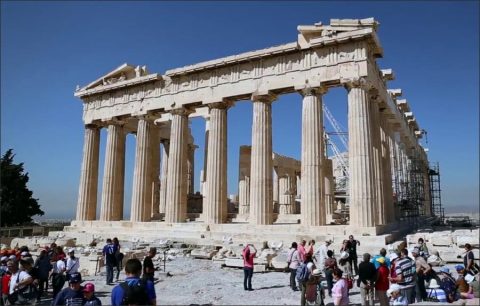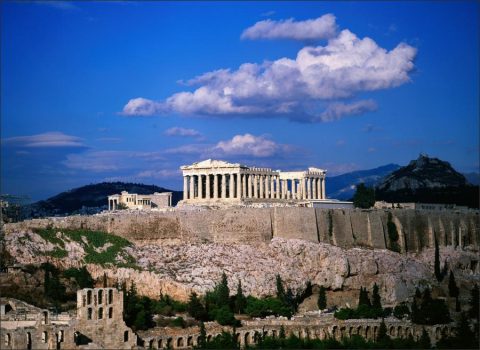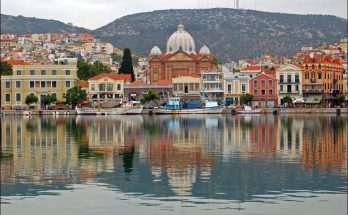For the works of Pericles . . . were perfectly made in so short a time and have continued so long a season. For every one of those which were finished at that time seemed to them to be very ancient touching the beauty thereof, and yet for the grace and continuance of the same it looketh at this day as if it were but newly done and finished; there is such a certain kind of flourishing freshness in it, which telleth that the injury of time cannot impair the sight thereof. As if every one of those foresaid works had some living spirit in it to make it seem fresh and young and a soul that lived for ever which kept them in their good continuing state.”
The development of the acropolis of Athens from the time when it was a pre-Hellenic sanctuary onward is so well researched and so widely known that repetition seems superfluous. One glance at the map of the acropolis even in Periclean times proves the volume-consciousness and space-blindness of its builders, which resulted practically in visual isolation of the respective structures. It explains also the complete lack of any axial references.
The tremendous differences in level within the sacred area contributed further to its irregularity, and only in the last Hellenistic centuries were attempts made–mostly unsuccessfully–to overcome them to a certain degree. The acropolis, the nucleus of early Greek towns, developed generally from a fortified place of refuge. The possibilities of an easy defense were decisive for its establishment.
So it became gradually the seat of the dominant power and eventually a sacred area, where temples, monuments, and altars were located, as were in earlier times the palaces of the kings. The acropolis was walled, but never became part of the fortification of the settlement which stretched beneath it. Once the whole town had become walled, the acropolis gradually lost its importance for defense. During the earlier archaic centuries it also served as a gathering place, a function which it lost to the agora with the increasing growth of the town proper.
On the acropolis, temples and statues were located according to topographical conditions of the hill. Often the respect for the tradition of previous sanctuaries or temples, sometimes dating back to prehistoric times, determined the site of later structures. But notwithstanding the representative character of the acropolis and the importance of its sacred area, no kind of space-creating relationship between the individual buildings can be observed. From the beginning to the very end of Greek civilization we find at the acropolis the same lack of an organized overall plan that is evident at the great sanctuaries, such as Eleusis, Olympia, and Delphi.
Without any doubt, the glorious temples, statues, and other monuments of an acropolis prove that the early Greeks, long before classical and Hellenistic times, had tried consciously to beautify and decorate their sacred areas. But quite obviously they did not aim at any kind of spatial unification and integration.
Space as such was neither felt aesthetically nor formed artistically from archaic Greek times through the sixth century B.C. The technique of spatial definition on a scale commensurate with human needs was not yet developed by the Greeks. It was volume, the mass of a structure or sculpture, that was of interest to the artist. Hence the acropolis represented but an accumulation of irregularly dispersed shaped volumes, each existing in its own right without being tied together into a spatial unit. Generally the desire for shaping space developed only very slowly after 500 B.C., steadily increasing in Hellenistic times until its culmination in Roman architecture and town planning, when it became the aesthetically decisive factor. But even then this spatial development referred only to the agora and never to the acropolis.
There is this other vision of the Acropolis of Athens as it might have been, or rather as it once existed in the great minds of that day–Pericles, Pheidias, Mnesicles, Ictinus, and others whose names even are lost. In this vision the Propylæa spreads two broad wings to guard the whole west front of the hill; the old haphazard buildings covering the north side are swept away, and in their place stands a temple, double, like the Propylæa, with two wings and two porches. There would then have been two temples on the Acropolis of equal dignity-the Parthenon, strong in simple lines and bold relief, and the Erechtheum, exquisite in its elaboration of ornament: one temple set up for the worship of Athena, the guardian of the health and wealth of the State, the giver of all good counsels, the daughter of Zeus, and the victorious rival of Poseidon; the other glorifying Athena, the home-goddess, the sister of Hephaistos, at once the craftsman’s conscience and his inspiration, and the friend of Erechtheus.
The serenity of Greek architecture must not blind us to the pregnant fact that the laws of art were still subservient to the common law of citizenship; the artist, no less than the soldier, put his service at the disposal of the State and accepted at her hands even the mutilation of his ideals.
The artists and statesmen of the greatest age gave magnanimously of their best, even though their dreams had to remain unrealized. It is only in the third millennium that their silence has been interpreted, and perhaps even this vindication of after-ages was as far from their wishes as from their thoughts. It is as though the makers of these temples had stamped upon them the device, “I abide by what I have done.”
Visits: 263




